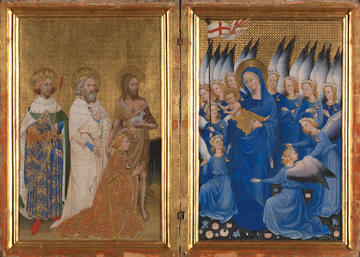NATIONAL TREASURES: The Wilton Diptych in Oxford - Press Release

This May, the Ashmolean Museum will be proud to display one of the greatest treasures to have survived from the Middle Ages: the National Gallery’s Wilton Diptych. The new display at the Ashmolean will be part of National Treasures, 12 simultaneous displays at museums and galleries around the country, all celebrating the National Gallery’s 200th anniversary. Opening on 10 May 2024, National Treasures: The Wilton Diptych in Oxford will be shown in the Ashmolean’s England 400–1600 Gallery, setting the painting among the Museum’s English collections, offering a new context for this well-loved and famous masterpiece. This will be the first time the diptych has ever been lent by the National Gallery since the painting was acquired in 1929.
The diptych is a painting on two oak panels, or wings, that are hinged together, allowing it to be opened like a book and stood upright to form a small devotional object. It was painted around 1395–9 by an unknown artist and is a rare survival of such a technically sophisticated medieval panel painting. It depicts a scene in two halves: on the left-hand wing is an earthly setting where King Richard II kneels to be presented by Saints Edmund, Edward the Confessor, and John the Baptist; on the right is the Heavenly court where the Christ Child is held by the Virgin Mary, surrounded by angels in a flower meadow. One angel holds a flag, possibly that of St George, and in the orb at the top is a tiny island which could represent England. On the exterior of the left-hand panel are the personal arms of Richard. On the other wing is a white hart or stag lying on a bed of flowers.
What is most remarkable is that the diptych was made for a king of England — Richard II who reigned from 1377—99. It was for Richard’s private use and as it was portable it could accompany him as he travelled and be used in various contexts, possibly as an aid to private worship.
Within the England Gallery, the object will be displayed among other collections which illuminate the diptych and offer new ways to learn about it. The symbolism in the diptych will be better understood by visitors who can see it surrounded by other contemporary royal objects. These include Ashmolean treasures, such as the funeral pall of Henry VII; and one of the most significant pieces of jewellery to survive from around the time of Richard’s death in 1400 — a gold reliquary ring found near Thame in Oxfordshire. A new audio tour, produced especially for the display, will help visitors engage with the painting and make connections with the collections in the England Gallery and elsewhere in the Museum.
Dr Xa Sturgis, Director of the Ashmolean Museum, says: ‘The Wilton Diptych is one of the National Gallery’s greatest treasures and it is a huge honour for the Ashmolean to be the first institution ever to borrow it. Setting it within the Museum’s England Gallery means the two greatest icons of English medieval kingship, the Alfred Jewel and the Wilton Diptych, will share a space for the first and last time.’
ENDS
CONTACT DETAILS
Claire Parris, Press and Publicity Manager
University of Oxford Museums and Gardens
claire.parris@ashmus.ox.ac.uk
07833 384 512
PRESS IMAGES
Images for editorial use are available to download at: https://go.glam.ox.ac.uk/WiltonDiptych
Caption:
The Wilton Diptych
English or French (?), about 1395-9
Egg on oak, 53 x 37 cm
National Gallery, London
NOTES TO EDITORS
Display: National Treasures: The Wilton Diptych in Oxford
Dates: 10 May-1 September 2024
Venue: Gallery 41, Ashmolean Museum, Beaumont Street Oxford OX1 2PH
Admission: Free




